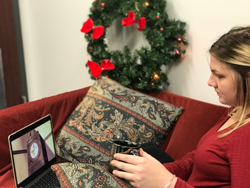“You can and you will,” I say to my mom who has stage four metastatic breast cancer. She was diagnosed four days before I moved into college my freshman year, and it became the new normal. Though this may not be the typical story of many college students, it surely could be the harsh reality.
I used to be avid about breast cancer awareness when I was younger, along with many others who avidly wore “I love boobies” bracelets in our middle school days, but I never even considered that my mother who is my absolute best friend, would fall victim to such an angering and insidious disease.
The stereotypical “It could happen to anyone at any time,” quote has been shouted at everyone from the rooftops. Does anyone ever think that it will hit home until it happens to them? Or, when it hurts the one person you love the most?
This further leads me along with many other advocates to encourage everyone to get an annual mammogram, as well as make sure the special women in their life also get checked yearly.
Sometimes, the tumors are too small to feel on your own, this is why the Affordable Care Act enables everyone to get screened at no cost.
Unfortunately, it appears many people overlook the importance of being proactive.
Dr. Jaime Myers assistant professor of health studies said, “Two organizations are generally considered the primary authorities on cancer prevention recommendations: the U.S. Preventive Services Task Force and the American Cancer Society. Between these two organizations, there have been a lot of changes in breast cancer prevention recommendations over the past 10 years.”
“Based on scientific evidence on mammography, both organizations have moved back their recommended screening ages, although there are variations still in the recommendations they provide. Since 2009, the U.S. Preventive Services Task Force recommends that women ages 50-74 get a mammography every other year,” she said.
“If you have symptoms, like a lump, or a history of breast cancer in the family, then mammography is recommended starting at 40 years old,” she continued.
According to Samantha Albinson, a junior nursing student, “I think awareness is huge. It is vital for women of all ages to know how to self-check for breast cancer. Something this simple can help with early detection which will lead to the care and treatment needed to combat breast cancer,” she said.
“Also when it comes to early detection, mammograms are so important. Keeping up with a regular schedule of mammograms as well as self-checks is crucial. We can stay on top of our own health and if/when an abnormality is detected get the help and testament that is needed right away,” Albinson continued.
Unfortunately, it is often misinterpreted that breast cancer is only a women’s disease. According to the American Cancer Society, “About 2,470 new cases of invasive breast cancer will be diagnosed and about 460 men will die from breast cancer.”
Many men, especially in the United States, overlook these statistics and end up being stricken with a disease that is often perceived as just happening to women.
Luckily, Monmouth is on top of teaching their nursing students about men’s breast cancer as well.
Senior nursing student, Melina Larouche said, “During our medical-surgical lectures we cover all types of cancer, including men’s and women’s breast cancer. As a nursing major, I also have guided nursing electives, one of which was Human Sexuality where we also discussed men’s and women’s breast cancer,” Larouche continued.
“As a nurse, there is the potential to be exposed to both sexes having breast cancer and to being able to identify it in both is important,” she commented.
Dr. Hettie Williams a lecturer of African American history in the history and anthropology department, agrees that many people are unaware that it affects males as well.
“I think students in gender studies tend to be aware, but outside of a gender studies class, it’s likely not the case and it’s probably because they don’t know how gender operates in society,” she said.
To identify breast cancer in both sexes is so essential when treating it, because it can manifest itself initially in so many different ways such as redness on the breast, nipple, or near the armpit, a lump beneath the skin, or dimpling of the skin. If you or a loved one identifies any of these on the body, it is best to go see a physician.
“If your family has a history of breast cancer, you might want to consider genetic testing for these genes to see if you are at increased risk,” Myers said.
Instead of just October being breast cancer awareness month, be aware all year round.
PHOTO COURTESY OF Cristina Medlin




